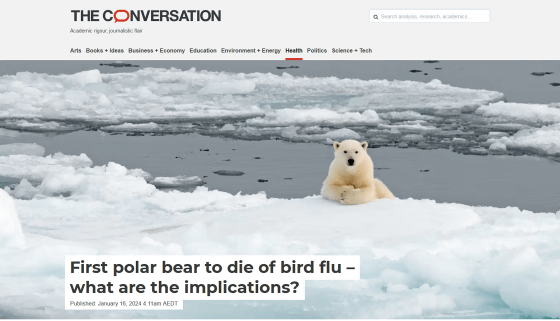This is the first confirmed case of a polar bear dying from avian influenza. What does this mean?

First polar bear to die of bird flu – what are the implications?
https://theconversation.com/first-polar-bear-to-die-of-bird-flu-what-are-the-implications-220603

Avian influenza (H5N1 type), which is prevalent at the time of writing, is known to infect a wide range of species, including not only birds but also mammals such as foxes, otters, mink, sea lions, and seals, and humans. Masu. It seems that even if it infects humans, it does not cause very severe symptoms, but the effects differ depending on the species.
The genes of influenza viruses change randomly through mutations, and also through genetic reassortment, which occurs when similar viruses infect the same cell and mix their genetic material. Ward points out that this may allow closely related viruses that infect the same host cells to exchange genetic material, facilitating adaptations such as host invasion, survival, and replication.

Due to the virus' high ability to adapt to the environment, avian influenza (H5N1 type) belonging to Clade 2.3.4.4b has been prevalent since 2021, and it is having a devastating impact on some bird populations. . However, the avian influenza (H5N1 type) prevalent at the time of writing has not been identified to have any specific genetic mutations that allow it to adapt to mammalian hosts. Additionally, since most of the mammals infected with avian influenza (H5N1) are carnivores, it is highly likely that carnivores are infected by preying on birds that have died from avian influenza (H5N1). About.
At the time of writing, a large number of seabirds had died from avian influenza (H5N1 type), so seals and polar bears may find dead seabirds whose colonies have been destroyed. Ward said: 'It's easy to imagine a flock of seals finding a colony of seabirds decimated by avian influenza (H5N1) and gorging themselves on the carcasses. Each seal would inhale large amounts of the virus. 'The large amount of virus may have overwhelmed the seal's immune system, leading to rapid infection and death without transmission between seals.'
It is unclear whether this polar bear found and ate a dead seabird, or whether it ate a seal that had already been infected with a large amount of avian influenza virus. This may become clearer in the future if more detailed virus tests and comparisons are made with viruses carried by surrounding animals.

At the time of writing, it is difficult to predict the future impact on polar bears and other large mammals due to the fact that a polar bear has died from avian influenza (H5N1 type).
If genetic testing reveals that the virus is poorly adapted to mammals, it is expected that the number of polar bears dying from avian influenza (H5N1) will hardly increase. However, since the influenza virus has a high adaptability, it is necessary to continue investigating the virus and prepare for the emergence of mutant strains that are adapted to mammalian hosts.
'The impact of avian influenza (H5N1) on some seabird colonies is devastating,' Ward said. This can lead to very serious consequences.'

◆Forum now open
A forum related to this article has been set up on the GIGAZINE official Discord server . Anyone can write freely, so please feel free to comment! If you do not have a Discord account, please create one by referring to the article explaining how to create an account!
• Discord | 'Have you been affected in any way by bird flu?' | GIGAZINE
https://discord.com/channels/1037961069903216680/1197466603785293856
Related Posts:







